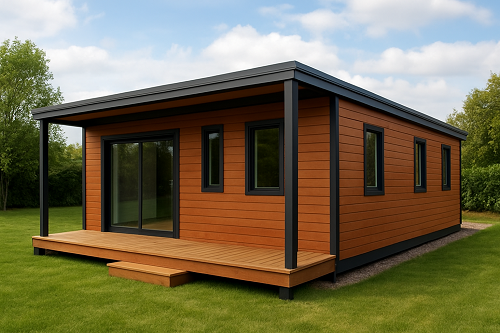The prefabricated house is designed as a versatile building solution that meets modern housing and commercial needs with efficiency and adaptability. Its primary function is to provide a comfortable, safe, and durable living or working space without the time and cost constraints of traditional construction. Prefabricated houses can serve multiple purposes—residential homes, office units, worker dormitories, disaster relief shelters, classrooms, clinics, or even temporary exhibition spaces. They are especially valuable in scenarios where quick deployment and mobility are crucial, such as construction project sites, mining camps, or emergency accommodation. Their modular design allows them to be easily transported, installed, dismantled, and reused, making them a sustainable alternative for industries and communities seeking flexibility and long-term value.
Prefabricated houses stand out because of their innovative structural design and material quality. They typically feature a modular steel framework combined with insulated wall panels, ensuring strong load-bearing capacity and effective thermal and sound insulation. The materials used are fireproof, waterproof, and resistant to corrosion, extending the overall lifespan of the structure. Many designs incorporate energy-efficient windows, ventilation systems, and customizable layouts, offering end users the ability to tailor the house to their specific needs. Beyond durability, prefabricated houses are known for their eco-friendly construction process, which significantly reduces material waste and on-site disturbance. The quick assembly system allows for installation in just a few days, compared to the weeks or months required for conventional buildings.
Prefabricated houses are manufactured in various sizes and configurations to meet different project requirements. Standard units usually range from 20ft to 40ft in length, with adjustable widths and heights depending on usage. Wall panels are commonly made with EPS, PU, or rock wool sandwich panels, offering excellent insulation against extreme climates. The steel structure is often Q235 or Q345 hot-dip galvanized steel, providing high structural strength and anti-rust performance. Flooring options include fiber cement board or PVC panels, while windows can be fitted with aluminum alloy frames and tempered glass. Electrical and plumbing systems are pre-installed or designed for quick integration, ensuring the house is ready for immediate occupancy once assembled. Customized specifications are available for customers requiring special layouts, multi-story stacking, or enhanced energy-saving designs.
Installing a prefabricated house is straightforward and does not require heavy construction equipment. Each unit is pre-engineered and delivered with detailed assembly instructions. A typical installation involves placing the steel frame, attaching insulated wall and roof panels, and connecting electrical and plumbing systems. Most models can be assembled by a small team within 2–5 days, depending on the size and complexity of the design. Prefabricated houses are also easy to relocate—units can be dismantled, transported, and reinstalled multiple times without losing structural integrity. Maintenance is minimal; periodic checks on joints, seals, and electrical connections are sufficient to ensure long-term performance.
The versatility of prefabricated houses makes them suitable for a wide range of industries. In the construction sector, they are widely used as site offices, worker accommodations, and storage spaces. In the energy and mining industries, they provide reliable housing in remote or harsh environments. In education and healthcare, prefabricated units are increasingly being used as classrooms, clinics, and temporary hospitals. Governments and NGOs also rely on prefabricated houses for disaster relief and resettlement projects, ensuring quick shelter solutions after natural disasters. Additionally, in the hospitality industry, prefabricated houses are being transformed into eco-resorts, guest cabins, and rental homes, catering to the rising demand for sustainable tourism infrastructure.
Prefabricated houses cater to a broad customer base, ranging from large-scale industrial enterprises to private individuals. Construction companies and real estate developers use them for on-site management and worker housing. Government agencies and humanitarian organizations turn to prefabricated houses for emergency relief and community resettlement. Educational institutions and healthcare providers adopt them for temporary classrooms, dormitories, and clinics. Small business owners benefit from using prefabricated houses as shops, offices, or workshops due to their affordability and flexibility. Meanwhile, private homeowners and eco-conscious buyers increasingly choose prefabricated houses as sustainable, customizable, and cost-effective alternatives to conventional housing.
